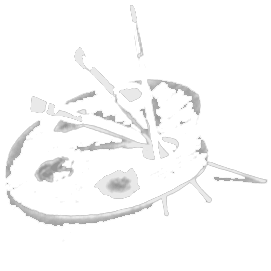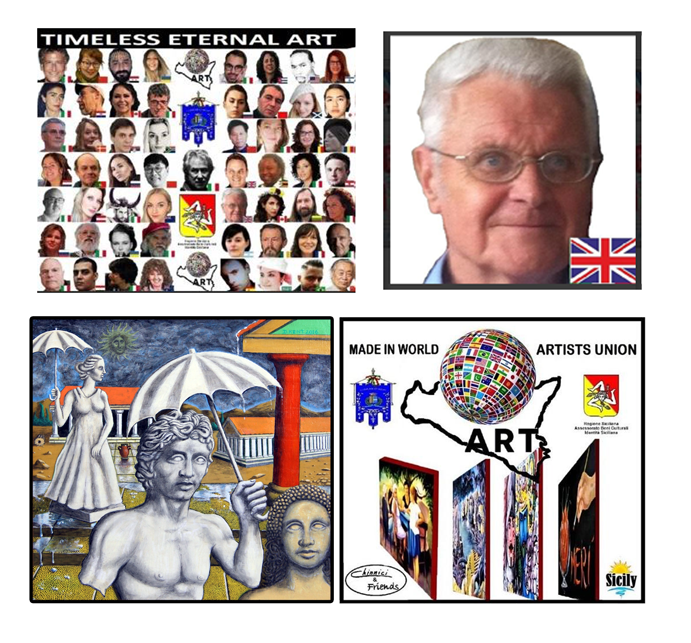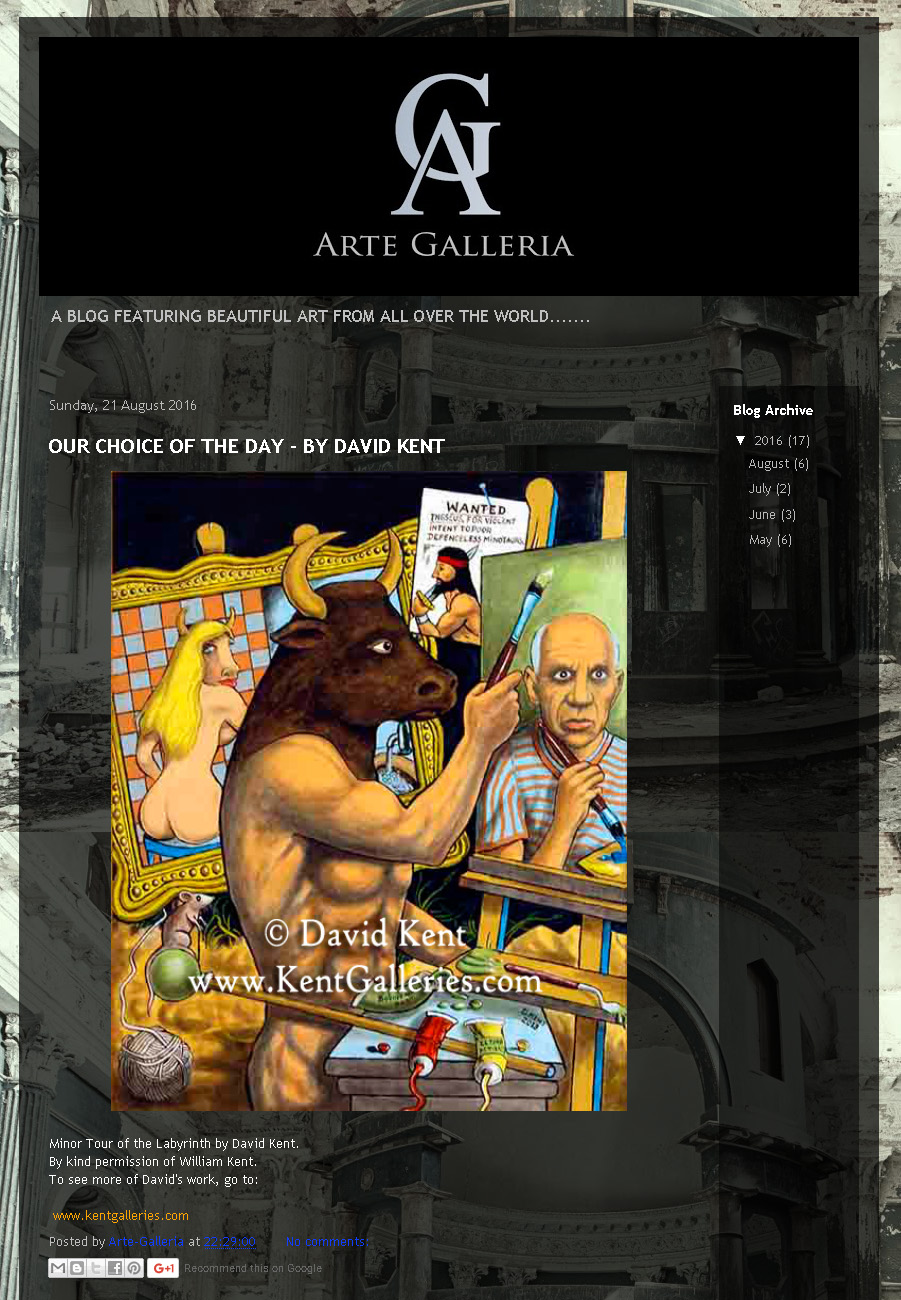The Buzz
This section is about the buzz around the artist and his artworks. Honourable mentions from
the press, media and also on-line, also some testimonials from some of our satisfied customers.

The Buzz about the Timeless Artists
(At Miri, Italy, Sicily January 2021)
“Meri – Timeless Eternal Art”, the revolution of the small town that becomes an eternal
open-air museum, giving immortality to 60 artists from all the nations of the world.
Municipal Support
The Mayor of the City of Merl Filippo Bonansinga, the Councilor Carmelo Arcoraci
‘believed in this project‘, the Deputy Mayor Antonino Siracusa and the entire municipal
administration in collaboration with Master Lorenzo Chinnici and his son Francesco
Chinnici to act as a trade union with artists from all over the world they are the architects
of an innovative project in the small Sicilian town. In truth, the main square and all the
streets ready to be transformed into a permanent museum with tiles painted by the
inspirational international artists.

The Immortality of Meri
Meri gives immortality to artists, who with their works, will be testimonials of the streets
of the town forever. Indeed an unprecedented combination of toponymy and art; fourteen
overall positions with terracotta tiles made by the artists are scheduled at and, around the
square. Further the twelve positions of pedestrian arches, where panels with photos of the
paintings will be installed, like those already placed for the author’s shelters.
“An unprecedented project, none like this exists, anywhere in the world. In fact, we are the
first to implement this artistic concept in Sicily, with the patronage of the Sicilian Region –
Department of Cultural Heritage and Sicilian identity.”
With the donation of the artists‘ works, Meri will decorate its streets and squares with artistic
works, creating a cultural path, an eternal, timeless exhibition that will ensure that the artist’s
name and work will be preserved, preserved, exhibited forever in the streets and squares
of the town epicentre of micro monuments dedicated to artists from all over the world.
Moreover, the artist’s name will always be remembered and visible to all the people who
visit this country.
The Buzz of an Open-air Gallery
“An open-air art gallery, but also a real urban regeneration project through art. Actually,
Meri and Sicily are candidates to become a model of a cultural renaissance, thanks to a
redevelopment project that can count on hundreds of international artists. ” In fact, the
first steps were started with the construction of the artistic bus shelters, dedicated to
Master Lorenzo Chinnici. Now the project involves the installation of works made on
terracotta tiles. ” Indeed, this ceaseless work is being carried out by the councillor
Carmelo Arcoraci, with passion and sacrifice, who since 2017 has never stopped
believing in this dream and has worked to make it come true.
All this becomes reality thanks to the mediation of the Painter Lorenzo Chinnici, an
artist appreciated all over the world, who has spent time himself in keeping contact with
other international artists. “Chinnici is almost 79 years old, has about 300 exhibitions
in many cities all around the world. In fact, son Francesco Chinnici stated: ” it is pure
energy, over 70 years of history, of international meetings and we have focused everything
on this small town, where my father was born, our experiences, paths.
The Buzz about further art projects to follow
Similar projects to that of Meri will also happen in China, featuring the same group of
artists. Sino- Italy Ningbo Ecological Park, together with Sino-Italy Tus-Investment
(Zhejiang) Co. Ltd., Huangshan City, “Tsung-Dao Lee Center of Sciences and Arts at the
University of Chinese Academy of Sciences” are among the first group of organizations
that have strong interests to host this project. Actually is thanks to the intermediation
of Emma XingYi Wang, the president of the G&Y Cultural Exchange Association from
Shanghai and Florence.
Here is the international cast of the artists:
- Lorenzo Chinnici (Italy)
- Zheng XiaoTong (China),
- David Kent (England)
- Craig Warwick (England),
- Farida Saba (Saudi Arabia)
- Patrick Smith (United States of America)
- Alisa Byteva (Russia)
- Dorina Nicoleta Crisu (Romania)
- Christine Bleny (France)
- lldo Domingos
- (Brazil), Jacqueline Scheffer (South Africa)
- Agnieszka Wioletta Meier (Poland)
- Giuseppe Gorga (Italy)
- Ingrid GG Pegge (Holland)
- Bojan Jevtic (Serbia)
- Isabella Young (New Zealand)
- Giovanni Gargano (Italy)
- Uliana Storozhylova (Ukraine)
- Jennings (Ireland)
- Giuseppe Messina (Italy)
- Aidas Rytis Vasiliauskas (Lithuania)
- Dimitri Salonia (Italy)
- A.Tinne Vereeck (Belgium)
- Linda Schipani (Italy)
- RuiManuel de Sousa Lourenco (Portugal)
- Shadi Abou Sada (Syria)
- Anne Gry Andersen (Denmark)
- Du Shusheng (China)
- Lucy Lago (Russia)
- Pino Morena (Italy)
- Helen Mortimer (Australia)
- Salvatore Imbesi (Italy)
- Tara Vahab (Canada)
- Vincenzo Campo (Italy)
- Olena Rudnieva (Ukraine)
- Francesca Licari (Italy)
- Adil Es-Safi (Morocco)
- Gianmaria Lafranconi (Italy)
- Zhang Jigang (China)
- Michela Velardita (Italy)
and our mascot the very young Kenta Leon Hayashy (Japan).
Proceedings were opened by the singing of an Ave Maria by Soprano Ekaterina Adamova (Russia)
to celebrate this artistic conglomeration. All without distinction, have worked hard to make this
town unique. “
Here is the article in Italian



The Buzz about “The Synergy of Sons”
Artworks by David Kent and Lorenzo Chinnici, Six Inches, Milan, 29 September 2015
Article by Marcello Francolini – Art Critic
A chance meeting
“The two artists meet up again, after more than forty years, thanks to a chance, but a
decisive encounter of their children. Resulting from a critical discussion about some
artwork. It seems to be the beginning of a story with a flavour of the past. Today in
our communication-rich society, in which we can meet and communicate at any time
of the day with any place of the world, it focuses on a bygone era for the two artists.
This reunion is something really symbolic, as-is also a chance meeting of their two
children. This acts as a demonstration of the consistency of these two artists. Who
after many years of mutual unknown journeys are found standing here in the same
bodies, though like clothes that are very frayed and worn, but etched with the vivid
ink of their experiences. This highlights the thoughts “to really see” both artists,
David Kent and Lorenzo Chinnici, moving away from just being a reality in
contemporary art, encountering perhaps a mystical aspect or a form of serendipity.
The subject and the Object
By “reality”, I refer to the practice now disruptive, in contemporary framing of
things, a process that sees its role in the re-definition of reality: ready-made. Here
nothing is closer, we perceive at once the distance with the reality of the picture to
be asked first. No works to be seen, but are ways to see through work.
As objects are arranged and are organized according to a predetermined way (as
in the case of ready-made) can go beyond their functionality to suggest new
meanings which are inevitably present here and expose themselves in their evidence
and their material flow occurs in the eventuality of reality.
This contrasts with the practice of these two artists, they are pursuing a way of
painting and yet remain silent in an attempt to abandon it, the significance of its
subject, and retrieve it as part of being acted out (in fact, the painting is not as an
observation post, but as the action of the work) we could define it as an imagined
idea, considering that everything is transformed (the painting is basically a job
and how this transformation happens) before it is imagined.
Works of Lorenzo Chinnici
Back to the Real (the Real Return) Critical reflections on the work of Lorenzo
Chinnici: How do we look at the works of Lorenzo Chinnici? Which side to measure
the features? Within which we can bring together the historical perspective? So it is
with these works that seem to be suspended in time. Some of them are finely veiled
touches of sea breeze, as the cycle of “fishermen”.
Behind these coatings, lie gestures simple but essential, on the whole, this retains a
genuine spontaneity to generate immediate empathy with the subjects
represented, their moods, their thoughts, what they have done and what we still
have to do.
This is evident in the close-ups, all the attention is focused on being. The viewpoint
has been lowered and puts the viewer in a state of confidentiality; the volume of the
bodies is magnified in volume. This simple majesty invites us to a pleasant intimacy
with the artist, and we can move to the territories of the beyond.
Emerging figures to fill the void
Prospects border on the skin of the figures, and yet such a short space that form and
emerges as bullies mending the status quo of an ancestral image of the world, now
abandoned by contemporary society. Who would not want to pause, at the dawn
of a Sicilian day at the foot of the Mediterranean? [I would like, for a moment, to
open a bracket around the “pause” for the viewer. “The pause” is a condition in which
man closes-out the world to learn to feel it, by looking at it.
“The pause” in this sense, today, is beyond doubt an action to rebel against the status
quo. I am reminded of the concept of Horror that “Plen Dorfles” presented in the
book of the same name in its opening of the twenty-first century, this horror of the
overflow, which corresponds to excess noise, both visual and auditory is the
polar opposite of any information and communication capacity.
Now, within this status quo, Dorfles, complained of the possibility of a break,
an estrangement with the ultimate goal of maintaining self-awareness, today
continually endangered. ]
Art to the movements of the sun
Many of the works of Chinnici, seem to come to light in the timetable that the sun
rises, many of his characters stop at dawn, as the Lampara, work, the others begin.
But what is this dawn that is revealed? It is in this dawn that shows the evidence
that takes form, in this time of day that despite all the pain, clears the body in its
towering majesty.
As we remember Nancy -until there is a body there is a dawn – and adds that – the
dawn is right, and also it extends from edge to edge. His mezzotint is not the
darkness of a conflict or contradiction.
It is the complicity of the places that opens and extends -So in the hour of sunrise
half-tone range and any difference in them fades and comes out being in its total
body of evidence and meat.
“Ecce Homo” for an artist like Chinnici is a “revelation” of the intimate things of
the world. His work seems to be fundamentally geographic from latitude, in which
they generate. Sicily located by rugged cliffs and sharp vertical profiles, suggests
the primacy of line and plane instead of being modulated and shapes; The African
sun burning landscapes requires the primitive force of colour instead of tone,
and atmosphere. Even the characters are those around him, part of the Sicilian
world.
But at the same time, these men have no identity, they do not recognize as
singular, but as a symbolic expression of the human being. Dispositio former
Clausione Linearum! (Arrangement produced by demarcating lines).
Critical reflections on the works of David Kent
David Kent, being English, reflects in his works, the custom design of the Anglo-
Saxon culture. A linear tradition that is nourished from Normandy architecture
of Durham Cathedral, and crossing the boundaries of English artists of the
sixteenth and seventeenth centuries to rejuvenate with the season of the
Pre-Raphaelites and bring his art to the twenty-first century with Pop-Art in
Hamilton, that the boundary line makes the more effective tool of imagination
and of reality.
The dichotomy of the Line
Here is the origin of the method of representation applied by David Kent. [I’d like
to open here a bracket on the structural function of the outline that emerges
clearly in theory, perhaps for the first time, in a medieval text: Commentaries in
Sententiarum of Bonaventure. William Blake said that only fools see outlines and
therefore they draw, but he also said that only the wise men see outlines and
therefore they draw. The fact is that the boundary lines do not exist in nature and
are instead the product of the process of abstraction precisely, as has been said
before each performance.]
Creative contours not found in nature
The contour line is the-way-in-which it releases the creative thinking of the artist.
Though it appears the evidence of the image that springs precisely from the figure/
background and the shape is well marked within its spatial arrangement. What is it
that we want to highlight in Kent’s work and of what form does it take?
It seems that the whole of his iconographic register is taken from the history of
culture, each work refers to an image which-in-itself embodies a particular concept.
For example, “Dali in Wonderland”, “Philosophy of Dreams” or “Snake and Ladders”
they are not, as erroneously claimed, “surrealist” works, but as works regarded as
Surrealism. The image of Dali, which inevitably leads to the urgency of a meta-
physical practice. This is not only a “tribute” to an end in itself, but takes on a more
quirky nature in the form of an idea, especially in today’s society of mathematical
rationalism.
Architect of Unconscious Chaos
Kent, within his work, shows wild imagination, a poster of the unconscious chaos,
the one defined by the choreographer Jean-Georges Noverre as Bel disorder
(disorder perspective and language disorder). At this point, I would be inclined
to move toward the original characters of the Pop-Art movement, that of an
English matrix, that contaminates the model representation, derived from the forms
of mass communication, but in-order-to involve a wider audience in the artistic debate.
From this perspective, Kent seems to be at the origins of what is considered in
today’s society as the “cartoon” whether used in cinematic advertising purposes: the
storyboard that he uses is, in most of his works to be found in the popular biography
of various artists and personalities of the eighteenth-twentieth century.
Building a different reality
I think if Kent had used various forms of expression today, he would be considered
as an original pop artist of the English movement; which he seems to join with some
illustration of the social customs of the time, it is the evolution of technical drawing
that comes in its transformation of his paintings. Kent’s technique is, therefore,
all English, – a “greatness” that is re-born in Kent, just like a gentleman who does
not get his hands dirty with reality, but building it as he sees fit.
Two painters, Kent and Chinnici, originating the painting from their own cultural roots;
one of the streets of Surrey and the other on the streets of Sicily.

Works of David Kent
An Article by Federica Pasini
“The image is formed in the heart of consciousness diversified depending on the
time, past, present, future; follows a kind of prism of specific representations
defined priorities. The images produced by David Kent possess a diversity of
existences, between psyche unconscious and conscious representation and
present: the dream images, hypnagogic images, fantasies semi-vigil, perceptions.
The image often designated ‘imago’, alluding to an interpenetration of “word”
and visual function, it is designed by our artist as a representational of uneasiness, ie
devoid of any consistency syntagmatic.
A character of Culture
Kent, in fact, is the fundamental character of culture, inserting objects in their
representations or otherwise iconic symbols and dreamlike subjective, the artist
can represent their ideas, values and thoughts, placing them in imaginative
unreality, with his work, brings us back to Kent Freudian reflection “in the
representations dream there is one principle, that of pleasure-displeasure. As
a reductive form of dreams, it is treated as an image of realized and illusory,
a representative prototype of non-being, mental activity is vital.
“Here, and nowhere else, Kent makes his work vital, meditative, illusory yet
absolutely real. The artist develops, so, a three-pronged strategy of seeing:
-farsi see, perform, attracting the gaze of others; -apparire different disguise,
deceive the eye; -rendersi invisible, disappear, escape to the eye; the obvious
deduction is that the pictures of our artist have a threefold function: active,
passive and, above all reflective.
History, Mythology and the Future
Thanks to Kent, the user is-able-to enter into historical images, from a mythological
perspective and futuristic provided by the method, absolutely original, the application
of colour and the strong choice of it; the courage shown by the artist brings his work
in the vanguard of the new contemporary aesthetic, able to translate the contradictions
and dissonances, the wounds of our age and its culture not be theorized as the society
in which we live.
Only right I see a monologue from Richard II: “I try to contain my mind as the
female with the sentiment. My feeling is the father; together they make a generation
of thoughts in turn generating; all these thoughts populate my little world, similar
in character to the great people of the world: because no thought is content with his
lot.” (Shakespeare, Richard II, Act V, Scene V) “

Customer Testamonials
“…they are great fun and depict popular people and characters.
He is a kind of surrealist Banksy! […]
I love them all!“
Mark (Cheshire)

“I just received The Watchers this morning, I’m absolutely thrilled with it! It made my Year.
[…] It will take pride of place in my Living room with a nice LED light to show it off!
I will get in touch in the future to purchase another painting (Not sure which one)
The picture was packaged to perfection!“
Carole (Highlands, Scotland)

“It’s here. It’s in mint condition, and the frame you chose is perfect.
I’m thrilled to have this painting. …a masterful job with the theme he chose.
Best wishes for the exhibition.
People need to think about ideas and not just decoration when they buy art.“
Charles (Texas, USA)

This section can be associated with the Art Exhibitions section.

The Buzz